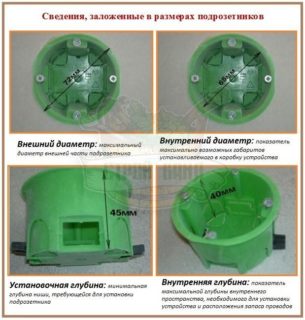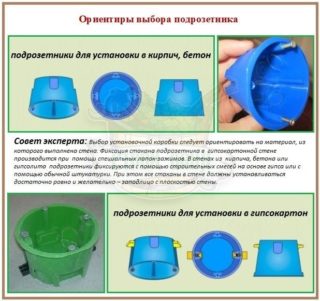When performing repair work, changing old power points to new ones, the diameter of the socket is extremely important, since it is necessary to make an appropriate nest for it in a concrete, brick or plasterboard partition. Knowing the standard parameters of the part, the master performs the work quickly and without problems.
Appointment of socket boxes
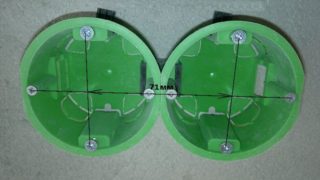
Special plastic boxes for an outlet are used to securely fix power points in the wall when installing hidden wiring. In addition, a fire-fighting function is assigned to the part. If a short circuit occurs in the wiring, the thick polymer wall of the socket does not support combustion. This is especially true for wooden walls sheathed with clapboard.
Sizes and types
Special wiring boxes are classified into several categories:
- The form. Round products are more common. Less often - square. The second option is used when installing non-standard power points.
- The type of wall into which the part is mounted. Here, such types of socket outlets are distinguished - for a concrete, brick, block wall or products for plasterboard. The latter are equipped with special fixing legs. In addition to gypsum plasterboard panels, such socket boxes are installed in walls and partitions made of chipboard, plywood, LSU sheets.
- Part type. There is a single socket, and there is a block element of 2-5 boxes, interconnected by a common frame. With the help of blocks, several sockets or switches can be installed simultaneously, located in a row vertically / horizontally. For any block boxes and single elements, the center distance is always 71 mm, which meets the standards.
Additionally, the socket boxes are classified by size.
Standard box parameters
There are also smaller installation parts on the market. Their depth is equal to 25 mm. In the most voluminous socket outlets, the parameter can reach 80 mm. In this case, the diameter sometimes changes by 60 mm. The shallow depth of the sockets is especially useful if you need to install two power points in one thin wall on both sides. Standard elements simply will not fit here or will protrude above the level of the partition plane.
Under the formation of a seat in the wall, you need to take a crown with a section of 70 mm for a perforator. These parameters allow you to freely set any diameter of a standard socket using the required amount of fixing solution. The master has 0.5-1 cm from the circumference of the element to be mounted.
The dimensions of the box for a square-type socket are 70x70 mm. Less common are products with dimensions of 60x60 mm.
70 mm means the parameter of the part at the base. That is, its protruding edges, edges and edges are often not taken into account. Sometimes the craftsman has to clean them up with sandpaper in order to mount the box in the nest.
Installation of the box in concrete and brick walls
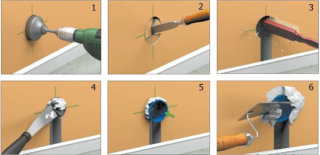
There is no clear regulation for the diameter of the socket boxes, in which partition they need to be installed.The value of 67-70 mm is equally suitable for any rosette, and even more so for the section of a diamond bit.
Before forming the nest, you need to dismantle the wallpaper section (if the installation is already done after finishing) and mark the panel. Then the crown is attached to the perforator, its axis is set clearly in the center and drilling is performed. In this case, the tool must be held strictly at an angle of 90 degrees in relation to the wall. During drilling and concrete sampling, the socket must be adjusted so that the depth of the socket matches it. The best option is one in which the round edge of the installation box is flush with the wall. All this is measured out by the building level.
When forming a nest in a brick wall, the drilling principle looks the same. The only difference is the depth of the nest. The installation box must be mounted in such a way that its edges fit perfectly with the finish of the brick walls. And it can be sheets of drywall, clapboard, plaster, etc. Probably here it would be more correct to use a deep socket. The main thing is to calculate the thickness of the finishing layer. If it is difficult to do this, it is better to drill after relatively fine work.
Wall mounting with tiles
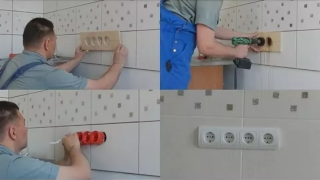
If the box is installed on a wall tiled with tiles, the diameter of the hole for the outlet remains the standard - 68-70 mm. Experts recommend making a nest even before laying the tiles. Here, markings are preliminarily applied to the panel and to the selected tile block. First, make a nest in the wall. Initially, its depth is not made very large, since it will increase due to the tiles laid on the glue. And this is an additional 1.5-2 cm.
The tile is drilled on the floor, laying a special board made of wood or drywall. To cut the tiles, you can use a perforator with a diamond crown, a hand saw or a jigsaw with a tungsten thread, a ballerina, and victory drills. The smoothest cut is obtained when working with a nibbler or a hammer drill attachment. Before performing work, it is advisable to soak the ceramic block for an hour in cold water. This increases the strength of the material.
If the wall is already tiled, the cut only needs to be done with a crown.
It is undesirable to put an outlet at the junction of two or four tiles. When the socket is formed in this way, the strength of the ceramic is reduced. Wall tiles can crack.
Installation of a socket in drywall
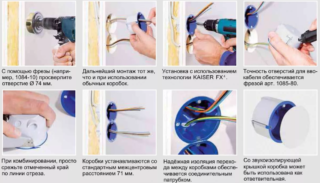
For gypsum plasterboard walls, the master must buy a special box with fixing legs. It does not need to be fastened with self-tapping screws. It is simply put into the panel due to the side fasteners.
When forming a nest in a plasterboard wall, they work with a special crown on the gypsum board. It is not recommended to press hard on the punch, as the panel is relatively fragile and can simply break.
As soon as the master reaches the main wall of concrete or brick, you need to change the crown to the appropriate one and continue drilling to the specified total depth.
How to choose an installation box
- Purpose: in which wall the sockets will be installed (in concrete, brick, drywall, wooden boards, etc.).
- Depth. This parameter is especially relevant if the master intends to put two parallel sockets on one wall on both sides. Here you should pay attention to shallow glasses of 25 mm.
- The form. The most popular is the round one. If the craftsman deals with non-standard power points, there is a reason to apply to square boxes.
- The type of block socket boxes, the way they are connected into one panel. Sometimes socket boxes are connected with specially purchased connectors. But it's good if the product already has special mounting slots.
- Product wall thickness. The larger it is, the less susceptible to melting and burning of the part. There are varieties of glasses on the market for this parameter from 2 to 4 mm.
Price and manufacturer are not the most recent criteria when purchasing an installation box. The consumer prefers to buy products from Kaiser (Germany), Courbi (Greece), SEZ (Slovakia), Schneider-Electric (France) or Kopos (Czech Republic).
Frequent mistakes when installing the installation box
During the execution of work, the masters often make the following flaws:
- They forget to pass the wiring cable into the technical holes of the socket. As a result, it is necessary to dismantle the product already fixed in the wall.
- The element is mounted before applying the finishing layer (plaster, decorative panels). Tiles are considered an exception.
- Use polyurethane foam instead of mortar to fix the installation box.
- Installation is carried out with a deviation from the axes of the cup holder in relation to the wall. In this case, when filling a niche with a solution, it "floats".
- Incorrect nest depth (more, less). And if the minimum can be increased, then too large in diameter or in depth will have to be filled with a large amount of solution.
A correctly installed socket remains stationary in its socket. This provides further full fixation and nourishment points.

